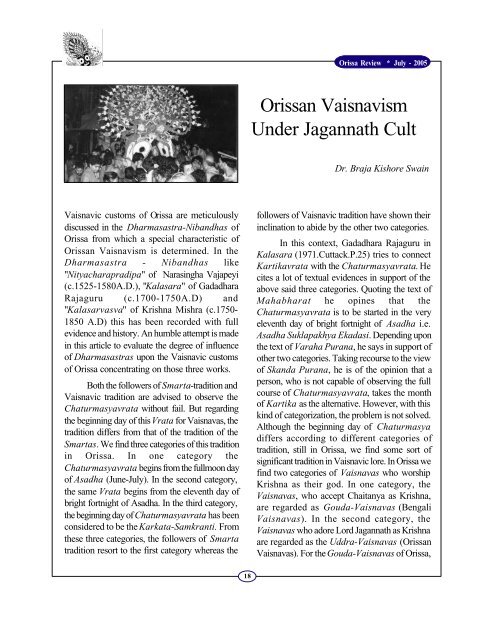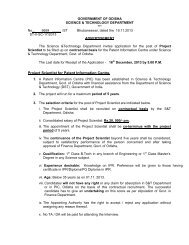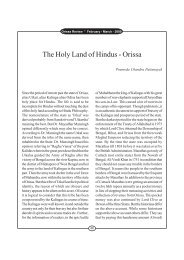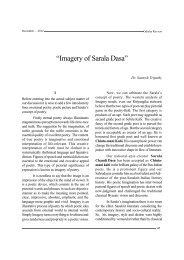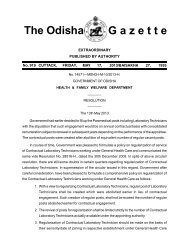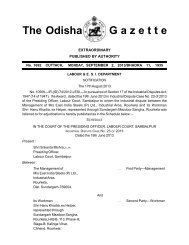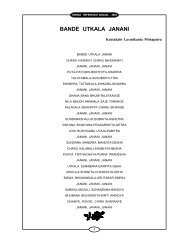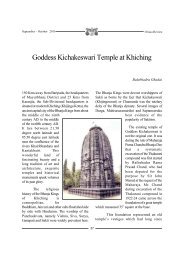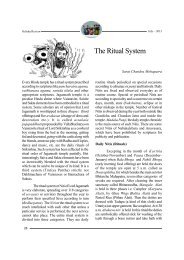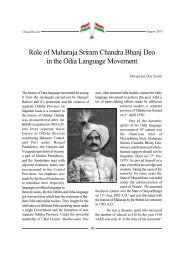Orissan Vaisnavism Under Jagannath Cult
Orissan Vaisnavism Under Jagannath Cult
Orissan Vaisnavism Under Jagannath Cult
Create successful ePaper yourself
Turn your PDF publications into a flip-book with our unique Google optimized e-Paper software.
Vaisnavic customs of Orissa are meticulously<br />
discussed in the Dharmasastra-Nibandhas of<br />
Orissa from which a special characteristic of<br />
<strong>Orissan</strong> <strong>Vaisnavism</strong> is determined. In the<br />
Dharmasastra - Nibandhas like<br />
"Nityacharapradipa" of Narasingha Vajapeyi<br />
(c.1525-1580A.D.), "Kalasara" of Gadadhara<br />
Rajaguru (c.1700-1750A.D) and<br />
"Kalasarvasva" of Krishna Mishra (c.1750-<br />
1850 A.D) this has been recorded with full<br />
evidence and history. An humble attempt is made<br />
in this article to evaluate the degree of influence<br />
of Dharmasastras upon the Vaisnavic customs<br />
of Orissa concentrating on those three works.<br />
Both the followers of Smarta-tradition and<br />
Vaisnavic tradition are advised to observe the<br />
Chaturmasyavrata without fail. But regarding<br />
the beginning day of this Vrata for Vaisnavas, the<br />
tradition differs from that of the tradition of the<br />
Smartas. We find three categories of this tradition<br />
in Orissa. In one category the<br />
Chaturmasyavrata begins from the fullmoon day<br />
of Asadha (June-July). In the second category,<br />
the same Vrata begins from the eleventh day of<br />
bright fortnight of Asadha. In the third category,<br />
the beginning day of Chaturmasyavrata has been<br />
considered to be the Karkata-Samkranti. From<br />
these three categories, the followers of Smarta<br />
tradition resort to the first category whereas the<br />
18<br />
Orissa Review * July - 2005<br />
<strong>Orissan</strong> <strong>Vaisnavism</strong><br />
<strong>Under</strong> <strong>Jagannath</strong> <strong>Cult</strong><br />
Dr. Braja Kishore Swain<br />
followers of Vaisnavic tradition have shown their<br />
inclination to abide by the other two categories.<br />
In this context, Gadadhara Rajaguru in<br />
Kalasara (1971.Cuttack.P.25) tries to connect<br />
Kartikavrata with the Chaturmasyavrata. He<br />
cites a lot of textual evidences in support of the<br />
above said three categories. Quoting the text of<br />
Mahabharat he opines that the<br />
Chaturmasyavrata is to be started in the very<br />
eleventh day of bright fortnight of Asadha i.e.<br />
Asadha Suklapakhya Ekadasi. Depending upon<br />
the text of Varaha Purana, he says in support of<br />
other two categories. Taking recourse to the view<br />
of Skanda Purana, he is of the opinion that a<br />
person, who is not capable of observing the full<br />
course of Chaturmasyavrata, takes the month<br />
of Kartika as the alternative. However, with this<br />
kind of categorization, the problem is not solved.<br />
Although the beginning day of Chaturmasya<br />
differs according to different categories of<br />
tradition, still in Orissa, we find some sort of<br />
significant tradition in Vaisnavic lore. In Orissa we<br />
find two categories of Vaisnavas who worship<br />
Krishna as their god. In one category, the<br />
Vaisnavas, who accept Chaitanya as Krishna,<br />
are regarded as Gouda-Vaisnavas (Bengali<br />
Vaisnavas). In the second category, the<br />
Vaisnavas who adore Lord <strong>Jagannath</strong> as Krishna<br />
are regarded as the Uddra-Vaisnavas (<strong>Orissan</strong><br />
Vaisnavas). For the Gouda-Vaisnavas of Orissa,
Orissa Review * July - 2005<br />
the Chaturmasyavrata is to be started with effect<br />
from the eleventh day of bright-fortnight of<br />
Asadha and concluded on the same day of the<br />
month of Kartika. In the same way the<br />
Kartikavrata is to be started from the eleventh<br />
day of bright-fortnight of Asvina and concluded<br />
on the same day of Kartika by them.<br />
For the <strong>Orissan</strong> Vaisnavas, the<br />
Chaturmasyavrata is to be started with effect<br />
from the fullmoon day of Asadha and concluded<br />
on the fullmoon day of Kartika. Here both<br />
Ekadasi and Punima are marked to be the two<br />
factors for making difference between the<br />
traditions of Gouda-Vaisnavas and Uddra-<br />
Vaisnavas. In this connection, Gadadhara<br />
Rajaguru is of the view that if Chaturmasyavrata<br />
or Kartikavrata is to be concluded on Kartika-<br />
Shukla-Ekadasi, the person who undergoes this<br />
Vrata has to observe Parana (taking usual food<br />
after fasting) on the very day of Ekadasi. But the<br />
Vaisnavas, to whichever seat they may belong,<br />
have to strictly observe fasting on the very day of<br />
Ekadasi. Therefore, in no way the Vaisnavas are<br />
advised to conclude Chaturmasya-vrata or<br />
Kartikavrata on the very eleventh day of brightfortnight<br />
of Kartika with this sort of argument<br />
and analysis of the texts or Sastras. Gadadhara<br />
Rajaguru opines that the Vaisnavas have to<br />
extend their Chaturmasyavrata or<br />
Kartikavrata up to the fullmoon day of Kartika<br />
inspite of the fact that they start it on different<br />
days. This is very much customary in the Temple<br />
of <strong>Jagannath</strong>.<br />
We find a number of references in support<br />
of observance of Chaturmasyavrata at Puri and<br />
Bhubaneswar. The Sastrakaras advise that the<br />
Smartas, Vaisnavas, Saivas or whoever they<br />
may be, should take the vow to remain at Puri or<br />
Bhubaneswar during Chaturmasya (Sravana-<br />
Bhadrava, Asvina and Kartika). The persons<br />
19<br />
who chose to reside at Puri, have to start this<br />
Vrata with effect from the eleventh day of bright<br />
fortnight of Asadha and conclude on the fullmoon<br />
day of Kartika. But for the persons who chose<br />
to remain at Bhubaneswar, the beginning date of<br />
Chaturmasya or Kartikavrata as the Ekadasi<br />
is not mandatory since it is a pilgrim center of the<br />
Saivites: Saiva-kshetra.<br />
It is observed that for the <strong>Orissan</strong><br />
Vaisnavas, the beginning day of Chaturmasya<br />
vrata or Kartikavrata may differ, but the<br />
concluding day must be the fullmoon day of<br />
Kartika i.e. Kartika Purnima. This is being<br />
practiced in the <strong>Jagannath</strong> Temple at Puri signifying<br />
the influence of Smarta-tradition upon <strong>Orissan</strong><br />
<strong>Vaisnavism</strong> under <strong>Jagannath</strong> <strong>Cult</strong>.<br />
In Puranic Smarta tradition, the Vaisnavas<br />
of Orissa are advised not to take the Naivedya<br />
of deities who are different from their Istadevata.<br />
This has been corroborated by citation from<br />
Krishna Mishra by the text of Skanda Purana,<br />
quoted in Kalasarvasva (Puri, 1997.P.379). We<br />
find some sort of liberal in this tradition of <strong>Orissan</strong><br />
<strong>Vaisnavism</strong>. In this connection, Narasingha<br />
Vajapeyi and Krishna Mishra express their views<br />
differently. From the views of Narasingha<br />
Vajapeyi it is understood that the Naivedya<br />
offered to any deity can be accepted, if it is offered<br />
according to the prescribed rules of any sect. But<br />
Krishna Mishra in Kalasarvasva (p.380) refutes<br />
this view of Narasingha Vajapeyi. He is of the<br />
opinion that this kind of Naivedya is prohibited<br />
for the Vaisnavas even though it is offered to any<br />
deity according to the prescribed rules of<br />
Vaisnavic Sastras.<br />
Apart from this view of Vajapeyi, attention<br />
of scholars may be drawn towards his second<br />
view. According to him, if a Vaisnava, in the daily<br />
worship of his Istadevata, offers Naivedya and<br />
takes it subsequently, thus demerit (pratyavaya)
of some sort in worship is created under the notion<br />
that anything dedicated to the deity is not to be<br />
taken back. But Krishna Mishra in Kalasarvasva<br />
(p.380) opines that the merit created in taking<br />
Visnu-naivedya after offering is greater than that<br />
of the demerit created by taking Visnu-naivedya<br />
in daily worship.<br />
It is observed that although these two views<br />
differ from one another, still in practice these two<br />
views are followed under certain conditional<br />
option (vyavasthita-vikalpa). Any Vaisnava<br />
householder belonging to any sect, does not take<br />
the Naivedya of the Istadevata of his own which<br />
is offered in daily worship. But the Vaisnava-<br />
Sanyasini and Vairagis are in favour of taking<br />
Naivedya even though it is offered in honour of<br />
own Istadevata i.e. <strong>Jagannath</strong>-Vishnu. This is<br />
maintained with the influence of Dharmasastras<br />
upon the <strong>Vaisnavism</strong> of Orissa under <strong>Jagannath</strong><br />
<strong>Cult</strong>.<br />
It is an accepted tradition all over India that<br />
Naivedyas of Siva is not to be taken even by the<br />
Saivites. But we find an exception in case of<br />
Naivedyas offered in honour of Lord Lingaraj at<br />
Bhubaneswar as recorded in Kalasarvasva of<br />
Krishna Mishra. According to him the Naivedyas<br />
offered to Lord Lingaraj is considered to be the<br />
Siva-naivedya. The Vaisnavas are inclined to<br />
consider it as Visnu-naivedya. Here Lingaraja,<br />
although a Siva, is treated as a devote of Lord<br />
Visnu. Since Vaisnavas or devotees of Visnu take<br />
the Naivedyas dedicated to Visnu, therefore,<br />
Lingaraja, being the devotee of Vishnu, is<br />
supposed to take Visnu-naivedya as a matter of<br />
fact. That is why anything offered to Lord<br />
Lingaraja, at first, is dedicated to Lord Visnu (i.e.<br />
<strong>Jagannath</strong>) and subsequently that is offered to<br />
Lingaraja. This conception in respect of<br />
acceptability of Naivedya gives encouragement<br />
to the Vaisnavas of Orissa to be liberal. On the<br />
basis of this, the Smarta-Vaisnavas show their<br />
20<br />
Orissa Review * July - 2005<br />
inclination to take Lingaraja (Siva) as Visnu and<br />
his naivedya as Visnu-naivedya. This peculiarity<br />
in <strong>Orissan</strong> <strong>Vaisnavism</strong> has been corroborated by<br />
Krishna Mishra with the help of Ekamra Purana<br />
quoted in Kalasarvasva (p.381)<br />
It is an accepted custom in Vaisnavic life in<br />
general that the Vaisnavas decorate their body<br />
with the signs of Visnu-ayudha i.e. mace, disc<br />
etc. and in order to remind the life of Krishna-<br />
Visnu to the public for the reason that they can<br />
recall the very theme of Krishna's life as well as<br />
the name of Krishna. It is noteworthy that Visnu<br />
smarana is one of the attonements of sins.<br />
As the sacred thread is used daily, similarly<br />
the signs of mace, disc etc. are decorated on the<br />
body. This sort of work has been included in the<br />
list of Vaisnavic nityakarma. But attaining nature<br />
call one has to wash off those signs decorated on<br />
the body and new signs of those ayudhas are to<br />
be drawn once again. We are told by the<br />
Dharmasastra-nibandhakaras that the old signs<br />
of the Visnu-ayudha are to be washed off and<br />
new signs along with tulasimala are to be taken<br />
before sandhya-bandana i.e. evening worship.<br />
Therefore, the Vaisnavas of Orissa decorate their<br />
bodies with the help of gopi-chandana twice daily.<br />
Narasingha Vajapeyi records this tradition in<br />
Nityacharapradipa (vol.I.P.358) which has been<br />
followed by Krishna Mishra in Kalasarvasva<br />
(p.384). From the stand point of Kalasarvasva,<br />
it is observed that Krishna Mishra fails to<br />
corroborate this tradition of <strong>Orissan</strong> Vaisnavas<br />
from the Sastras. Moreover he tries to vindicate<br />
this tradition from the local customs of Orissa using<br />
the very term "ata eva bruddhah".<br />
According to the Vedic Smarta-tradition,<br />
the Brahmins are entitled to enter into Sanyasa-<br />
Ashrama. Others are not allowed for the same.<br />
They are allowed only upto the<br />
Vanaprasthashrama. In Vaisnavic tradition all are
Orissa Review * July - 2005<br />
allowed to follow sanyasa-ashrama according<br />
to Agamic provision irrespective of castes. This<br />
way the Sanyasins, initiated in Vaisnavic<br />
dikhsya, are divided into four sects namely<br />
Sanaka, Sri, Brahman and Rudra. In Orissa the<br />
Sanyasins of Sanaka sect are the worshippers<br />
of Krishna. The Sanyasins of Shri sect are<br />
marked to be the worshippers of Laksmi and<br />
Narayana or Sita and Rama. Unlike those, the<br />
Sanyasins of Brahma sect are the followers of<br />
Madhava. In <strong>Orissan</strong> Viasnavic tradition, the<br />
house-holder Vaisnavas belong to the Shri sect.<br />
Followers of this sect usually worship Laksmi and<br />
Narayana and that is why the house-holder<br />
Vaisnavas are advised to take initiation from a<br />
particular sectarian guru who is a householder<br />
Vaisnava himself. In case of a householder life, if<br />
the husband is initiated into a Vaisnavic faith and<br />
the wife desires to take initiation subsequently,<br />
she has to take permission from her husband.<br />
Krishna Mishra corroborates this tradition by<br />
quoting a Puranic smriti-text quoted in<br />
Kalasarvasva (p.369)<br />
In case of a widow, the tradition goes in a<br />
different way. <strong>Under</strong> the rule of Sri sect the widow<br />
can take Narayana-mantra through a Vaisnavic<br />
initiation and becomes eligible to worship<br />
Salagrama Narayana. In <strong>Orissan</strong> <strong>Vaisnavism</strong>,<br />
the widow initiated to <strong>Vaisnavism</strong> is treated as a<br />
Sanyasini belonging to kutichara-category. The<br />
widows who belong to Sri sect are entitled to<br />
worship Krishna also alongwith Radha. But if they<br />
are initiated in Sanaka sect, they are allowed to<br />
worship Vasudeva Krishna instead of Gopinath<br />
Krishna or Radhakrishna. In this way the<br />
householder life for Vaisnavas in Orissa differs<br />
from sect to sect. For the Vaisnavas of Brahma<br />
sect, the parafernalia of Madhava school are to<br />
be followed. Although the Nibandhakaras have<br />
taken much pain in framing rules for Vaisnavas<br />
under Smriti principles, still they have taken<br />
Bhagavata Mahapurana as their chief authority.<br />
21<br />
Taking recourse to this sort of endeavour,<br />
Mitra Mishra the celebrated author of<br />
Viramitrodaya has compiled a volume devoting<br />
this area designating it as Bhakti Prakasa. For<br />
rationalization of Vaisnavic tradition in Orissa,<br />
Krishna Mishra has written Bhakti Sarvasva like<br />
Bhakti Prakasa incorporating all the dicta meant<br />
for <strong>Vaisnavism</strong>, the lines of which are found quoted<br />
in Kalasarvasva. But unfortunately<br />
Bhaktisarvasva has not been discovered so far.<br />
This way many facts of <strong>Vaisnavism</strong> in Orissa under<br />
<strong>Jagannath</strong> <strong>Cult</strong> are traced in the Dharmasastra<br />
works of Orissa.<br />
It is submitted that<br />
(a) The <strong>Orissan</strong> Vaisnavas have accepted<br />
<strong>Jagannath</strong> as Krishna;<br />
(b) the <strong>Orissan</strong> Vaisnavas very prominently<br />
mark the association of Hari with Hara in<br />
Dola Yatra, as a result of which Saivism<br />
has been amalgamated in <strong>Vaisnavism</strong> and<br />
Vice-versa;<br />
(c) in <strong>Orissan</strong> <strong>Vaisnavism</strong> worship of Durga<br />
has been accepted. Here Visnu or Krishna<br />
is designated as Madhava. In this way<br />
Durga-Madhava worship has been evolved<br />
in course of time. During Dussehra in the<br />
month of Asvina Durga-Madhava Yatra is<br />
observed.<br />
These three points show deeper degree of<br />
influence of Smritis on the <strong>Vaisnavism</strong> of<br />
Orissa.<br />
It is suggested that an attempt may be made<br />
to trace out the inter-relationship of <strong>Vaisnavism</strong>,<br />
Saivism and Shaktism under <strong>Jagannath</strong> <strong>Cult</strong>.<br />
Notes<br />
1. Asaktah Kartike masi Vratam Kuryat<br />
puroditam//Kalasara Cuttack, 1971.P<br />
2. Caitanyamatanuyayigaudavaisha Vaistu<br />
asvinasu Klaikadasim yavat Vratamacaryate.
Tara sukdaikadasyam parne samyak pramanam<br />
na drsyate. It tatpaksepi purnimaparyantam<br />
Vratacaranam samicinam. Tatha cacarasya<br />
sripurusottamaksetre jagannathaprasade<br />
darsanat Kalasarvasva p.25.<br />
3. Bhuktvanya devanaivedyam dvijascandrayanam<br />
Caret. Kalasarvasva, Puri, 1997, p.379.<br />
4. Yadyapi vajapeyibhir Vidhinaivedyamapi<br />
dvijabha & samuktam tathapi tad vaisnavanisiddham.<br />
Kalasarvasva, p.380.<br />
5. Ibid.<br />
6. Yadyapi svapujakratavisnunaiveddyam<br />
pujavaigunyaya svabhaksymiti<br />
vajapeyebhinuktam, tadapi tadvai gunyalpadoso<br />
visnunaivedyasanaphalabhumna<br />
kupakhanakan..eva. Kalasarvasva, p.380<br />
7. Yo manarcya naro bhunkte bhavita tasya<br />
gaurava m' itye kamrapurne bhubanesvaranaivedyasya<br />
Visnudeyatvat 'na lingam<br />
bhuvavesvarah' iti tasya sivatvanisedhapurvaka<br />
visnutvati desacca lingarajanaivedyam<br />
smartavaisnavabhaksyam Pratiyate.<br />
Kalasarvasva, p.381.<br />
22<br />
Orissa Review * July - 2005<br />
8. At eva brddhah-yanopavitabaddharyah samkha<br />
cakradikam malamutradau promckhayanti……<br />
idamanusandhaya singhavajapeyibhirapi<br />
Snananantaram sandhyatah singhavjapeyibhirapi<br />
snananantaram sandhyatah purvam<br />
tulasipadmaksa-didharanamuktumiti dik.<br />
Kalasarvasva, p.384.<br />
9. "Strinam Visesat dadyat patibhaktismanvitam"<br />
patyanujnakrtam diksamityarthah.<br />
Kalasarvasva, p.369<br />
10. There are four grades of sannyasins namely<br />
Kuticara,bahudaka,hamsa and Paramahamsa.<br />
The window-sannyasins of Orissa are<br />
considered to be Kuticura category in Vaisnavic<br />
tradition.<br />
Dr. Braja Kishore Swain is the Upacharya in the Post<br />
Graduate Dept. of Dharmashastra in Sri Jaganath<br />
Sanskrit University, Sri Vihar, Puri-752003.


